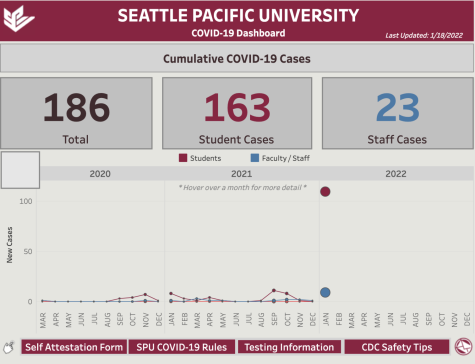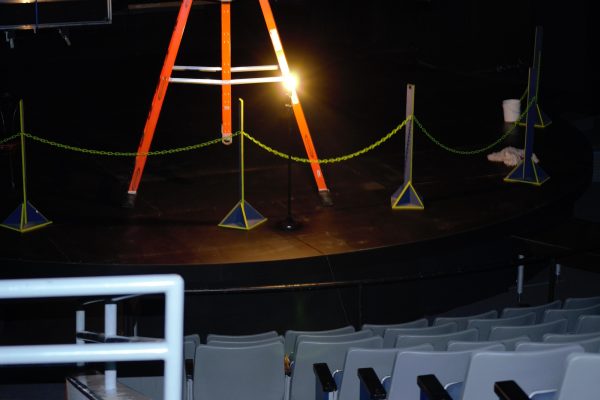On the rise
Increased COVID-19 cases spark concern around campus
January 19, 2022

Jan. 3 was the day students were able to move back on campus, Jan. 10 was the day in-person teaching resumed after one week of online classes. As of Jan.14, there have been 118 positive cases of COVID-19 on campus.
Compared to winter 2021, this is a significant spike in cases. According to the COVID-19 Dashboard on the SPU website, there were only nine positive cases last January.
Jeff Jordan, vice provost for student information and community engagement, was able to shed more light on the recent changes and the decision group’s plan for the future.
“We’re getting close to utilizing all [campus apartments] at this point,” Jordan said.
Normally when someone on campus tests positive for COVID-19, they are put into isolation in one of the campus apartments.
Protocols for COVID-19 are different than they were a year ago when the Omicron variant did not exist. With the combination of the increased rate of spreading, in-person classes and a high demand for testing, students are very concerned for their safety and that of others.
Sophomore psychology major Savannah Terry expressed concern after having a negative experience with in-person classes.
“I went to my first in-person class on Monday and I got sick the next day,” Terry explained. “I’m still waiting to be tested for COVID-19, but because of all the high cases I’m having trouble getting the test since so many people are in the same boat as me.”
Even getting tested can be a struggle for students because of the rise in cases. People get tested everyday at Health Services if they are exhibiting symptoms or if they are in close contact with someone infected.
Terry is not the only student noticing the struggle to get tested. Junior illustration and honors liberal arts major Pierce Papke also noticed the issue.
“As a student worker, it’s stressful navigating the fact that SPU has nearly doubled its almost two year long COVID count in a matter of two weeks,” said Papke. “What’s difficult is that we are still expected to resume daily activities, all while testing sites are being overwhelmed.”
Junior nursing major Lizzy Carlson became frustrated over the rising number of cases and the risk of contracting COVID-19 through in-person classes.
“Since coming back to campus, I have had six high risk exposures, and those are just the ones I’ve been notified of,” said Carlson.
Students’ biggest concern is the in-person teaching, and some wish SPU would go back to online just for a couple more weeks to get cases under control. Sophomore English major J Sheeres would have preferred online over in-person learning to lower the risk of exposure.
“Though many students struggle with online classes, myself included, online classes keep students and staff safer,” said Sheeres. “In what was supposed to be my first week of in-person classes, I had two thirds of my professors exposed to COVID-19.”
On Jan. 14, the COVID-19 Decision Group sent an email to students notifying them on the new protocols concerning COVID-19. One notable change is the decrease in days of isolation.
According to the Health Services webpage, “You may end isolation after seven days if you have had no fever for more than 24 hours and your symptoms are improving.”
The COVID-19 Decision Group hopes that the update on the new protocols will provide clarity for students and staff in the event questions arise.
“What we’re trying to do as much as possible is give enough direction so that students and employees both have some type of guidance for them to follow instead of having our limited health services trying to get in touch with them,” Jordan explained.
Health services have a limited staff, and with the high demand for testing not everyone is able to get tested.
“No one saw Omicron coming down this path. This is not just SPU, this is nationally as well, and that’s why testing is hard to find anywhere,” said Jordan. “We are looking at testing options for our campus. We have been working with a third party, we have not secured a deal with them yet but we are working on it diligently.”
Although some students prefer in-person over online learning, many do not want to risk getting exposed.
“A hybrid approach would have been safer and more beneficial,” said Sheeres. “The rise in cases comes from the rise of students in quarantine, but students are left relying on their classmates’ notes, because the class is fully in-person and have no way to join virtually.”
Some students wondered if professors were even able to give an online option for class in the event they tested positive for COVID-19 and had to quarantine.
“We’ve given that authority and flexibility to our faculty,” explained Jordan.
Then when asked if online classes would be an option in the near future, Jordan expressed that for now in-person classes will stay around.
“If you’re looking at the likelihood for a decision for next week, the answer is no. But the COVID-19 decision group will continue to monitor what we have going on our campus and what is going on around as well,” Jordan said. “There are a number of schools in the country in-person, so we’re not terribly unusual.”
As of now, protocols surrounding campus life will remain the same, with the addition of KN95 masks available in residence halls as the COVID-19 Decision Group continues to look at the data and monitor the situation.

























































































